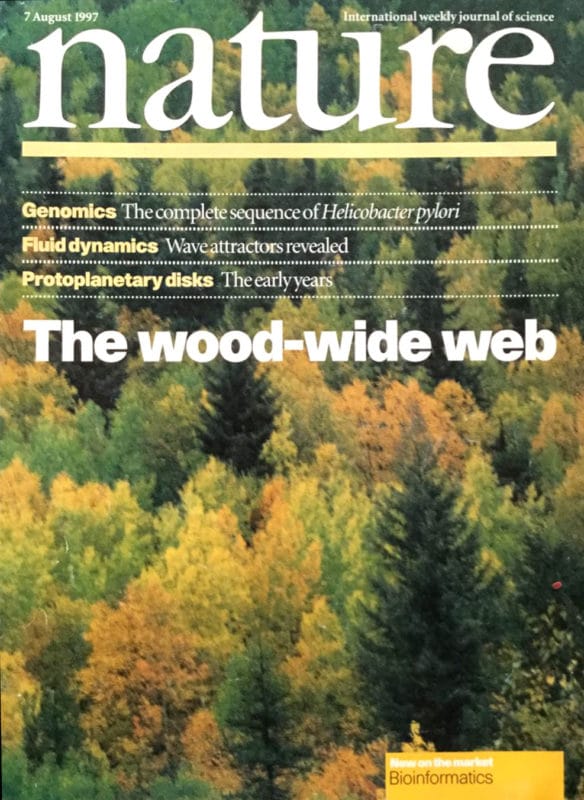The Mother Tree Project & Program builds on three decades of research by Dr. Simard and her lab, which has produced numerous journal articles, book chapters and conference presentations on tree communication.
Selected Publications
Simard, S.W., Perry, D.A., Jones, M.D., Myrold, D.D., Durall, D.M., Molina, R.(1997). Net transfer of carbon between tree species with shared ectomycorrhizal fungi. Nature 388: 579-582.
Teste, F.P., Simard, S.W., Durall, D.M., Guy. R.D., Jones. M.D., Schoonmaker, A.L. (2009). Access to mycorrhizal networks and tree roots: importance for seedling survival & resource transfer. Ecology 90: 2808-2822.
Beiler, K.J., Durall, D.M., Simard, S.W., Maxwell, S.A., Kretzer, A.M. (2010). Mapping the wood-wide web: mycorrhizal networks link multiple Douglas-fir cohorts. New Phytologist 185: 543-553.
Deslippe, J.R., Simard, S.W. (2011). Below-ground carbon transfer among Betula nana may increase with warming in Arctic tundra. New Phytologist 192(3): 689-698.
Simard, S.W., Beiler, K.J., Bingham, M.A., Deslippe. J.R., Philip, L.J., Teste, F.P. (2012). Mycorrhizal networks: mechanisms, ecology and modelling. Invited Review. Fungal Biology Reviews 26:39-60.
Bingham, M.A., Simard, S.W. (2013). Seedling genetics and life history outweigh mycorrhizal network potential to improve conifer regeneration under drought. Forest Ecology and Management 287:132-139.
Simard, S.W., Martin, K., Vyse, A., Larson, B. (2013). Meta-networks of fungi, fauna and flora as agents of complex adaptive systems. In: Puettmann, K, Messier, C, and Coates, K.D. (eds.) .Managing World Forests as Complex Adaptive Systems: Building Resilience to the Challenge of Global Change. Routledge, NY. Chap. 7, pp. 133-164. ISBN 978-0-415-51977.
Beiler, K.J., Simard, S.W., Durall, D.M. (2015). Topology of Rhizopogon spp. mycorrhizal meta-networks in xeric and mesic old-growth interior Douglas-fir forests. Journal of Ecology 103(3): 616-628.
Simard, S.W. (2015). Conversations in the forest: The roots of natures equanimity. SGI Quarterly 79: 8-9.
Song, Y.Y., Simard, S.W., Carroll, A., Mohn, W.W., Zheng, R.S. (2015). Defoliation of interior Douglas-fir elicits carbon transfer and defense signalling to ponderosa pine neighbors through ectomycorrhizal networks. Scientific Reports 5: 8495.
Gorzelak, M., Pickles, B.J., Asay, A.K., Simard, S.W. (2015). Inter-plant communication through mycorrhizal networks mediates complex adaptive behaviour in plant communities. Annals of Botany Plants 7: plv050.
Pickles, B.J., Wilhelm, R., Asay, A.K., Hahn, A., Simard, S.W., Mohn, W.W. (2016). Transfer of 13C between paired Douglas-fir seedlings reveals plant kinship effects and uptake of exudates by ectomycorrhizas. New Phytologist 214: 400-411.
Simard, S.W. (2017). The mother tree. K. Verlag and the Haus der Kulturen der Welt, Berlin, A Springer, A-S. and Turpin, E. (eds.).The Word for World is Still Forest. ISBN 978-3-9818635-0-5.
Simard, S.W. (2018). Mycorrhizal networks facilitate tree communication, learning and memory. In: Baluska, F., Gagliano, M. and Witzany, G. (eds.), Memory and Learning in Plants. Springer. Chap. 10, pp. 191-213. ISBN 978-3-319-75596-0.
Defrenne, C.E., Philpott, T.J., Guichon, S.H.A., Roach, W.J., Pickles, B.J., Simard, S.W. (2019). Shifts in Ectomycorrhizal Fungal Communities and Exploration Types Relate to the Environment and Fine-Root Traits Across Interior Douglas-Fir Forests of Western Canada. Frontiers in Plant Science 10:643.
Asay, A.K., Simard, S.W., Dudley, S.A. (2020). Altering neighborhood relatedness and species composition affects interior Douglas-fir size and morphological traits with context- dependent responses. Frontiers in Ecology and Evolution 8: 314.
Simard, S.W., Roach W.J., Defrenne, C.E., Pickles, B.J., Snyder, E.N., Robinson, A., Lavkulich, L.M. (2020). Harvest Intensity Effects on Carbon Stocks and Biodiversity Are Dependent on Regional Climate in Douglas-Fir Forests of British Columbia. Frontiers in Forests and Global Change 3(88).
Van Dorp, C., Simard, S.W., Durall, D.M (2020). Resilience of Rhizopogon-Douglas-fir mycorrhizal networks 25 years after selective logging. Mycorrhiza 30: 467–474.
Simard, S.W., Roach, W.J., Beauregard, J., Burkart, J., Cook, D., Law, D., Schacter, T., Murphy-Steed, A., Zickmantel, A., Armstrong, G., Fraser, K.M., Hart, L., Heath, O.R.J., Jones, L., Sachs, N.S., Sachs, H.R., Snyder, E.N., Tien, M., Timmermans, J. (2021). Partial retention of legacy trees protect mycorrhizal inoculum potential, biodiversity and soil resources while promoting natural regeneration of interior Douglas-fir. Frontiers in Forests and Global Change 3.
Roach, W.J., Simard, S.W. Defrenne, C.E., Pickles, B.J., Lavkulich, L.M., Ryan, T.L. (2021). Tree diversity, site index, and carbon storage decrease with aridity in Douglas-fir forests in western Canada. Frontiers in Forests and Global Change 4.
Published graduate theses

Cover of the August 1997 issue of Nature, where the term “wood-wide web” was coined in reference to the paper “Net transfer of carbon between ectomycorrhizal tree species in the field” by Simard et al.
Other Publications
- Finding the Mother Tree by Suzanne Simard (May 2021)
Publications – Full list
Click on the link below for a full list of publications related to The Mother Tree Project & Program.
View all Publications




